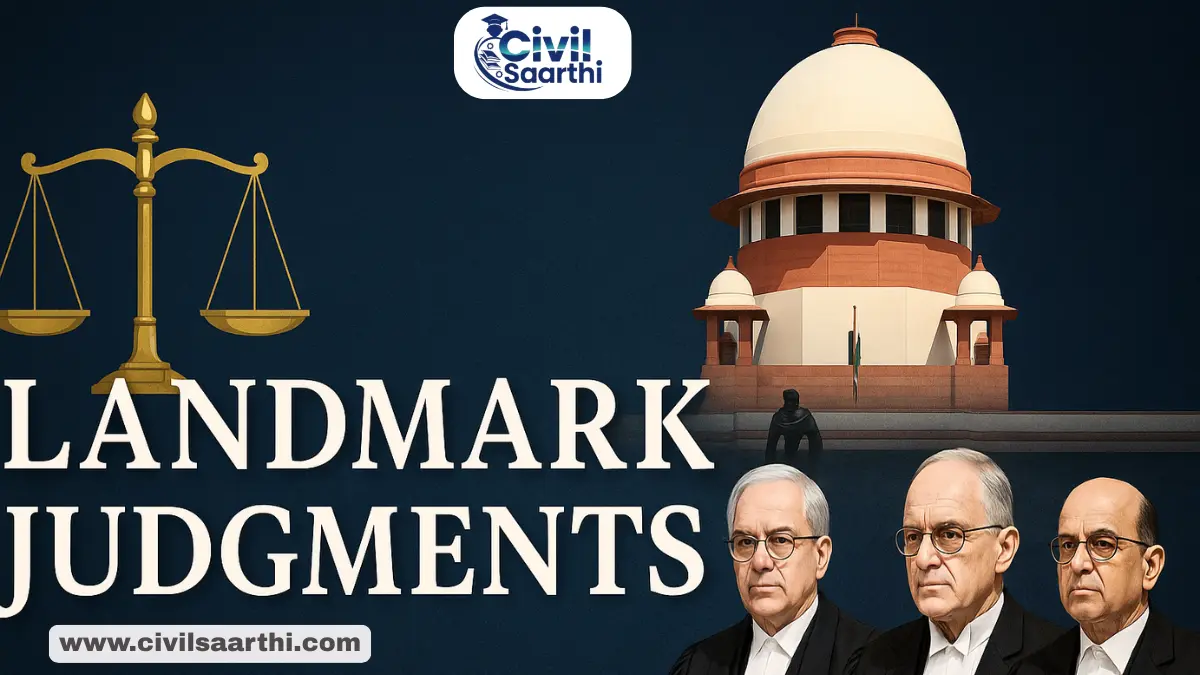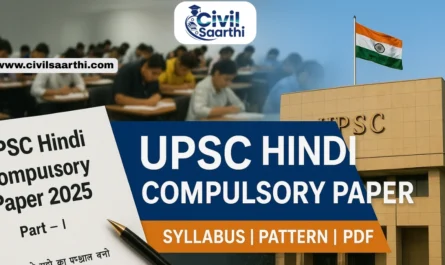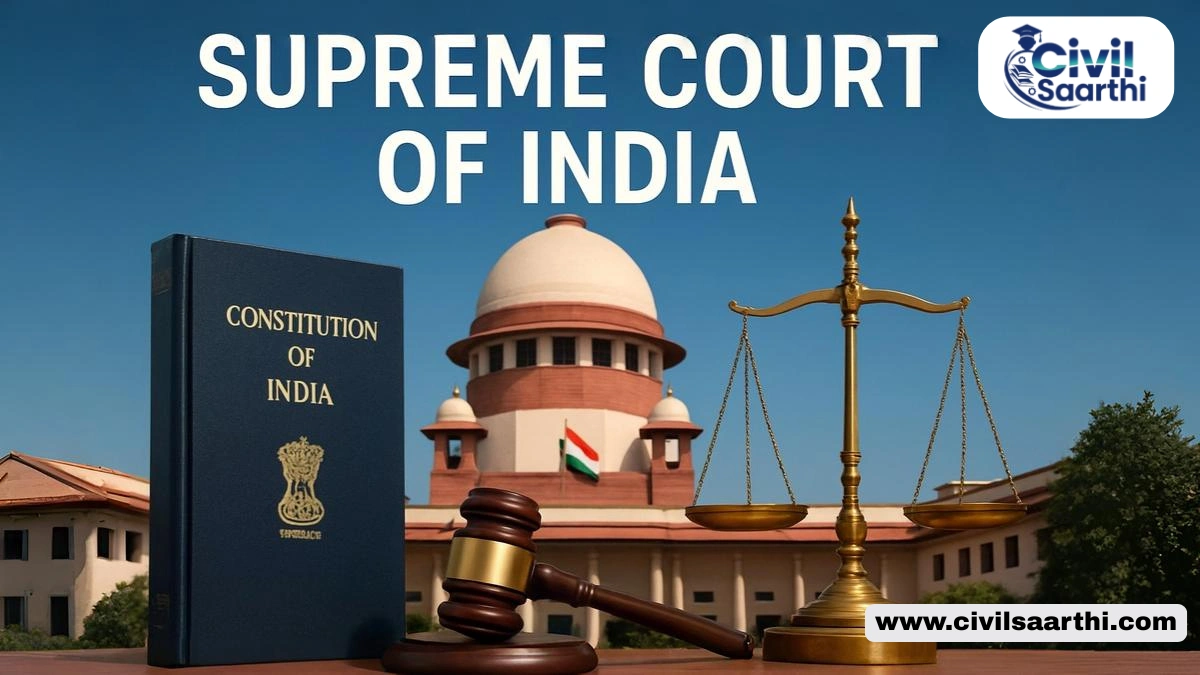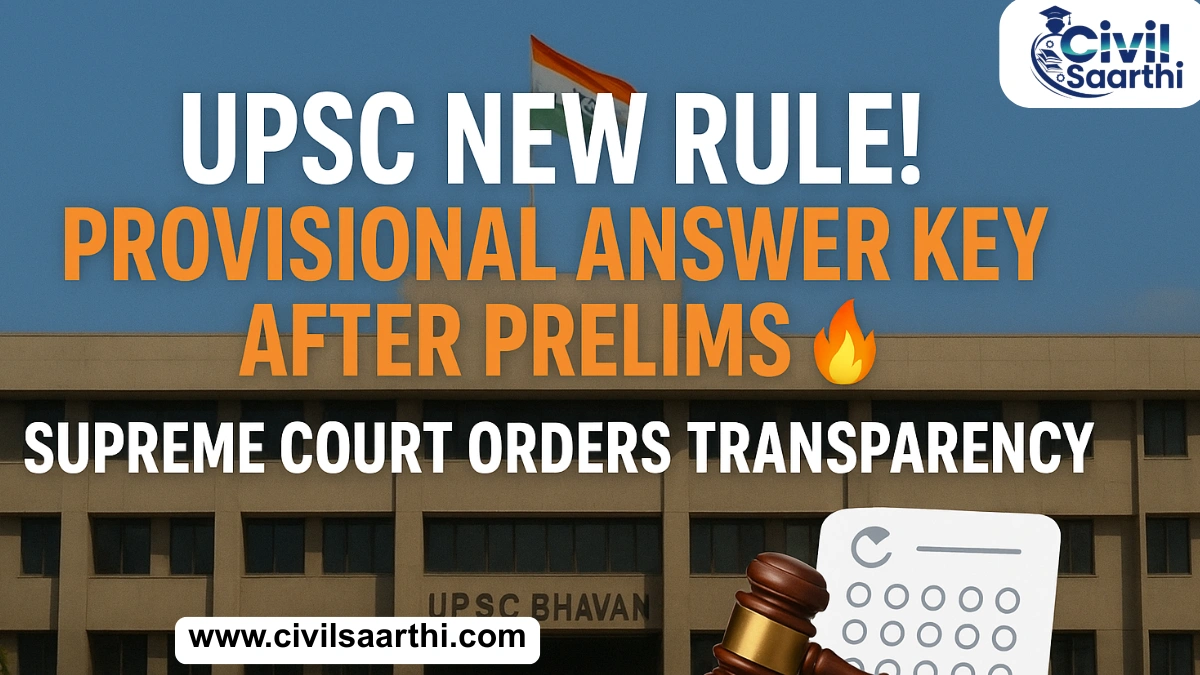Landmark judgments delivered by the Supreme Court of India form the bedrock of constitutional governance. These path-breaking verdicts shape the balance between fundamental rights, state power, individual freedoms, and socio-economic justice. For UPSC aspirants, understanding these judgments is crucial for Prelims, Mains (GS II and Essays), and Interview.
This article covers major Supreme Court judgments from 1950 to 2025 in a detailed and structured manner. Each judgment is explained with context, legal issue, principle laid down, and its significance in Indian polity.
What Are Landmark Judgments?
Landmark judgments are judicial pronouncements that clarify constitutional provisions, reinterpret laws, or lay down new legal principles. Such judgments often lead to legislative, social, or executive reforms and become precedents in Indian constitutional law. These rulings often address:
- Fundamental Rights and their scope
- Federal structure and Centre-State relations
- Powers of different organs of government
- Issues of social justice, reservation, gender equality, and secularism
Landmark Supreme Court Judgments: Summary
Landmark Supreme Court judgments are milestone decisions by the apex court that have shaped India’s constitutional and legal framework. These rulings interpret, expand, or restrict fundamental rights, federalism, and democratic values, forming the backbone of Indian jurisprudence.
Landmark Supreme Court Judgments: Summary | ||||
| Case Name | Year | Issue | Principle Established | Constitutional Change |
| A.K. Gopalan | 1950 | Preventive detention | Procedural law suffices | Overruled later |
| Champakam Dorairajan | 1951 | Caste-based reservations | FR > DPSPs | 1st Amendment |
| Golaknath | 1967 | FR amendment | FRs cannot be amended | 24th Amendment |
| Kesavananda Bharati | 1973 | Amending power | Basic Structure Doctrine | Defined limits |
| Indira Gandhi v. Raj Narain | 1975 | Election disputes | Democracy as Basic Structure | 39th Amendment struck |
| ADM Jabalpur | 1976 | Emergency powers | No FRs during Emergency | Overruled |
| Maneka Gandhi | 1978 | Passport impoundment | Due process mandatory | None |
| Minerva Mills | 1980 | FR-DPSP conflict | Balanced both | Struck 42nd Amendment parts |
| Bachan Singh | 1980 | Death penalty | Rarest of rare doctrine | None |
| Shah Bano | 1985 | Muslim women maintenance | Sec 125 CrPC applicable | MW Act, 1986 |
| Indira Sawhney | 1992 | OBC reservation | 50% cap, creamy layer | None |
| SR Bommai | 1994 | Article 356 misuse | Federalism protected | None |
| TMA Pai | 2002 | Minority education | Administer institutions | None |
| IR Coelho | 2007 | Ninth Schedule | Judicial review allowed | None |
| Aruna Shanbaug | 2011 | Euthanasia | Passive euthanasia valid | None |
| Puttaswamy | 2017 | Privacy | FR under Article 21 | Overruled ADM Jabalpur |
| Navtej Johar | 2018 | Section 377 | Decriminalized LGBTQ+ | Colonial law struck down |
| Joseph Shine | 2018 | Adultery | Gender equality | Section 497 struck |
| Sabarimala Case | 2018 | Temple entry | Gender rights upheld | Under review |
| Anuradha Bhasin | 2020 | Internet ban | Article 19 includes internet | None |
| Pegasus Case | 2021 | Surveillance | Need for safeguards | None |
| Supriyo Chakraborty | 2023 | Same-sex marriage | Deferred to Parliament | None |
| Electoral Bonds | 2024 | Political funding | Scheme unconstitutional | Finance Act provisions struck |
Landmark Judgments and Their Resulting Constitutional Amendments
Landmark Judgments and Constitutional Amendments, showing the key Supreme Court verdicts and the constitutional amendments they triggered:
Landmark Judgments and Their Resulting Constitutional Amendments | |||
| Supreme Court Judgment | Year | Amendment Triggered | Key Change in Constitution |
| Romesh Thappar v. State of Madras | 1950 | 1st Amendment (1951) | Added “reasonable restrictions” to Article 19(1)(a) – free speech |
| Golaknath v. State of Punjab | 1967 | 24th Amendment (1971) | Gave Parliament power to amend Fundamental Rights |
| RC Cooper v. Union of India | 1970 | 25th Amendment (1971) | Strengthened DPSPs, limited right to property & judicial review |
| Kesavananda Bharati & Indira Gandhi v. Raj Narain | 1973–75 | 42nd Amendment (1976) | Reduced scope of judicial review; expanded Parliament’s powers |
| ADM Jabalpur v. Shivkant Shukla | 1976 | 44th Amendment (1978) | Made Article 21 non-suspendable during Emergency |
| Unnikrishnan v. State of Andhra Pradesh | 1993 | 86th Amendment (2002) | Added Article 21A – Right to Education for children 6-14 |
| Cooperative Society Reform Cases | 2000s | 97th Amendment (2011) | Gave constitutional status to cooperative societies (Part IXB) |
| Indra Sawhney v. Union of India | 1992 | 103rd Amendment (2019) | Introduced 10% EWS quota – Articles 15(6) and 16(6) |
| Jaishri Patil v. Maharashtra | 2021 | 105th Amendment (2021) | Restored states’ power to identify Socially & Educationally Backward Classes (SEBCs) |
Landmark Judgments Related to Fundamental Rights
Landmark Judgments related to Fundamental Rights have played a pivotal role in interpreting and expanding the scope of Articles 14, 19, 21, and 25–30. These judgments ensure the protection of equality, liberty, life with dignity, freedom of religion, and minority rights, forming the bedrock of Indian constitutional democracy.
| Article | Case Name | Year | Issue | Judgment Summary / Principle Established |
| Article 14 | EP Royappa v. State of Tamil Nadu | 1974 | Equality before law | Introduced test of arbitrariness as violation of Article 14 |
| Maneka Gandhi v. Union of India | 1978 | Personal liberty linked with equality | Expanded scope of Article 14 through due process logic | |
| Navtej Singh Johar v. Union of India | 2018 | LGBTQ+ rights | Struck down Section 377 IPC as discriminatory and violative of Article 14 | |
| Article 19 | Romesh Thappar v. State of Madras | 1950 | Freedom of speech | Press freedom upheld; led to 1st Constitutional Amendment |
| Bennett Coleman v. Union of India | 1973 | Newspaper regulation | Freedom of press protected under Article 19(1)(a) | |
| Shreya Singhal v. Union of India | 2015 | Internet freedom | Struck down Section 66A of IT Act; protected online speech | |
| Article 21 | Maneka Gandhi v. Union of India | 1978 | Passport impounded arbitrarily | Due process is essential; fair procedure required under Article 21 |
| Francis Coralie Mullin v. UT of Delhi | 1981 | Prisoner’s rights | Right to live with dignity part of Article 21 | |
| Olga Tellis v. Bombay Municipal Corporation | 1985 | Right to livelihood of pavement dwellers | Livelihood part of right to life | |
| MC Mehta v. Union of India | 1986 | Environment and life | Clean environment integral to right to life | |
| Puttaswamy v. Union of India | 2017 | Right to privacy | Privacy declared as intrinsic part of Article 21 | |
| Common Cause v. Union of India | 2018 | Passive euthanasia | Right to die with dignity upheld | |
| Article 25-30 | Bijoe Emmanuel v. State of Kerala | 1986 | Right to religion (school prayer refusal) | Children cannot be expelled for not singing national anthem – Article 25 |
| S.R. Bommai v. Union of India | 1994 | Secularism and religious freedom | Held secularism is part of Basic Structure, protected by Articles 25-28 | |
| Shirur Mutt Case | 1954 | Autonomy of religious denominations | Distinguished between religious faith and secular activities | |
| T.M.A. Pai Foundation v. State of Karnataka | 2002 | Minority educational institutions | Reaffirmed rights of minorities under Article 30 | |
| Indian Young Lawyers Association v. State of Kerala (Sabarimala Case) | 2018 | Entry of women into temple | Entry denial held discriminatory; religious practice cannot override equality |
1950s: Laying the Foundation of Constitutional Law
1. A.K. Gopalan v. State of Madras (1950)
This judgment interpreted Article 21 narrowly, holding that personal liberty could be curtailed through a valid law without concern for due process. It treated each fundamental right as distinct and unrelated. This view was overturned in later judgments.
- Principle: Procedural due process not required
- Change: No constitutional change; later overruled
2. State of Madras v. Champakam Dorairajan (1951)
The Court ruled that caste-based reservations violated Article 15(1), establishing the precedence of Fundamental Rights over Directive Principles. It led to the First Constitutional Amendment.
- Principle: FRs override DPSPs
- Change: First Constitutional Amendment (Article 15(4) added)
1960s: Restricting Parliament’s Power
3. Golaknath v. State of Punjab (1967)
This decision held that Fundamental Rights could not be amended by Parliament, asserting their inviolability. The judgment was overruled by the 24th Constitutional Amendment.
- Principle: FRs cannot be amended by Parliament
- Change: 24th Amendment (1971) permitted FR amendment
1970s: Basic Structure and Democratic Protections
4. Kesavananda Bharati v. State of Kerala (1973)
This 13-judge bench laid down the Basic Structure Doctrine, stating that Parliament’s power to amend the Constitution does not extend to altering its basic structure.
- Principle: Basic Structure Doctrine established
- Change: Doctrine limited amending power
5. Indira Nehru Gandhi v. Raj Narain (1975)
The Court struck down Article 329A(4), introduced via the 39th Amendment, as violating free and fair elections, a part of the Basic Structure.
- Principle: Elections and democracy are basic structure elements
- Change: Part of 39th Amendment invalidated
6. ADM Jabalpur v. Shivkant Shukla (1976)
Held that the right to life under Article 21 could be suspended during Emergency. Widely criticized and later overruled.
- Principle: FRs suspended during Emergency
- Change: Later overruled by Puttaswamy (2017)
7. Maneka Gandhi v. Union of India (1978)
Expanded Article 21 by ruling that any law depriving personal liberty must be just, fair, and reasonable. Connected Articles 14, 19, and 21.
- Principle: Due process required under Article 21
- Change: None; altered constitutional interpretation
1980s: Reaffirming Judicial Review and Rights
8. Minerva Mills v. Union of India (1980)
Struck down parts of the 42nd Amendment that gave primacy to DPSPs over FRs. Reasserted the importance of balance and Basic Structure.
- Principle: Balance between FRs and DPSPs is part of Basic Structure
- Change: Invalidated portions of 42nd Amendment
9. Bachan Singh v. State of Punjab (1980)
Upheld the death penalty but restricted it to the “rarest of rare” cases to prevent misuse.
- Principle: Rarest of rare doctrine for capital punishment
- Change: None
10. Mohd. Ahmed Khan v. Shah Bano Begum (1985)
Recognized the right of a divorced Muslim woman to maintenance under Section 125 CrPC. Led to the enactment of a separate Muslim Women Act.
- Principle: Maintenance rights under secular law
- Change: Muslim Women (Protection of Rights on Divorce) Act, 1986
1990s: Social Justice and Federal Integrity
11. Indra Sawhney v. Union of India (1992)
Upheld OBC reservations but introduced the “creamy layer” concept and capped total reservations at 50%.
- Principle: Creamy layer and 50% cap on reservations
- Change: None
12. S.R. Bommai v. Union of India (1994)
Placed restrictions on misuse of Article 356 by holding that President’s Rule is subject to judicial review. Strengthened federalism.
- Principle: Federalism is a part of Basic Structure
- Change: None
2000s: Minority Rights and Ninth Schedule
13. T.M.A. Pai Foundation v. State of Karnataka (2002)
Reinforced the rights of minorities to establish and manage educational institutions under Article 30.
- Principle: Minority education rights upheld
- Change: None
14. I.R. Coelho v. State of Tamil Nadu (2007)
Held that even laws in the Ninth Schedule are open to judicial review if they damage the Basic Structure.
- Principle: Judicial review extends to Ninth Schedule
- Change: None
2010s: Right to Privacy and Individual Dignity
15. Aruna Shanbaug v. Union of India (2011)
Permitted passive euthanasia under strict guidelines, recognizing the right to die with dignity.
- Principle: Passive euthanasia allowed under right to life
- Change: None
16. Justice K.S. Puttaswamy v. Union of India (2017)
Declared privacy as a fundamental right under Article 21. Overruled the ADM Jabalpur ruling.
- Principle: Right to Privacy is a Fundamental Right
- Change: Overruled earlier precedent
17. Navtej Singh Johar v. Union of India (2018)
Decriminalized consensual homosexual acts by reading down Section 377 IPC. Affirmed LGBTQ+ rights.
- Principle: Equality and dignity of LGBTQ+ individuals
- Change: Colonial law struck down
18. Joseph Shine v. Union of India (2018)
Struck down Section 497 IPC, decriminalizing adultery and affirming gender equality.
- Principle: Gender equality and personal autonomy
- Change: Section 497 IPC removed
19. Indian Young Lawyers Association v. State of Kerala (2018)
Permitted entry of women of all ages into Sabarimala temple, invoking gender equality. Under review by a larger bench.
- Principle: Gender equality in religious matters
- Change: None (Pending review)
2020s: Technology, Surveillance, and Electoral Reforms
20. Anuradha Bhasin v. Union of India (2020)
Declared that freedom of speech under Article 19 includes access to the internet. Set limits on arbitrary shutdowns.
- Principle: Internet essential to free expression
- Change: None
21. Manohar Lal Sharma v. Union of India (Pegasus Case) (2021)
Addressed concerns about illegal surveillance. The Court ordered an independent investigation.
- Principle: State surveillance must be constitutionally justified
- Change: None
22. Supriyo Chakraborty v. Union of India (2023)
Denied constitutional validity to same-sex marriages but emphasized the need for legislative action.
- Principle: Marriage equality requires legislative action
- Change: None
- Association for Democratic Reforms v. Union of India (Electoral Bonds Case) (2024)
Struck down the Electoral Bonds Scheme for violating transparency in political funding.
- Principle: Transparency in electoral finance
- Change: Amendments to Finance Act and RP Act nullified
Important Landmark Judgments FAQs
What are Landmark Judgments?
Landmark Judgments are key Supreme Court rulings that have established significant legal principles and shaped constitutional interpretation.
Which is the most important Landmark Judgment for UPSC?
The Kesavananda Bharati case is the most important as it laid down the Basic Structure Doctrine.
Is Maneka Gandhi a Landmark Judgment?
Yes, it expanded the meaning of personal liberty under Article 21 and is among the most cited Landmark Judgments.
Why are Landmark Judgments important for UPSC Mains?
They provide legal precedents and constitutional interpretations essential for answer writing and essay papers.
How to study Landmark Judgments for UPSC?
Focus on the year, issue, principle established, and its long-term impact. Use charts and tables for quick revision.
Can Landmark Judgments be overturned?
Yes, through larger constitutional benches or constitutional amendments (unless barred by Basic Structure).
Are Landmark Judgments asked in UPSC Prelims?
Yes, UPSC frequently asks about years, outcomes, and principles of Landmark Judgments in Polity and Current Affairs.







